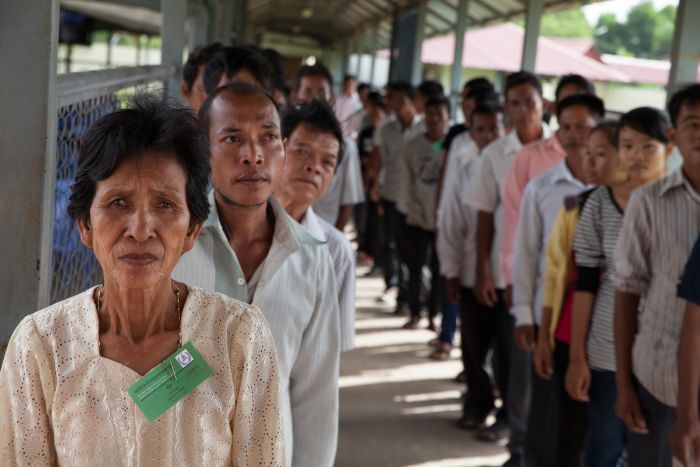What Did the UN Do with Turatsinze’s Information?
Due to the seven-hour time difference between Kigali and New York, the “genocide fax” reached the UN on the evening of January 10. A UN spokesman, Fred Eckhard, explained later that officials felt that Dallaire had to be kept “on a leash” as he was “champing at the bit” (Toronto Globe and Mail, September 25, 1997). Worried that the UNAMIR commander was exceeding his authority, UN officials drafted an immediate reply ordering him to take no action on the information from Turatsinze until he had received “clear guidance.”
Even though this reply bears the signature of Kofi Annan, then head of UN peacekeeping operations, markings show that it was actually drafted by his assistant, Iqbal Riza. The following day, Riza drafted a more considered reply to Dallaire, describing the proposed raid on the alleged arms caches as clearly “beyond the mandate entrusted to UNAMIR” under UN Security Council resolution 872. Traumatized by memories of the loss of 20 UN peacekeepers in Somalia two months earlier, New York ordered Dallaire to refrain from any “course of action that might lead to the use of force and unanticipated repercussions.”
In place of the proposed arms raid, Dallaire and Booh-Booh were instructed to inform President Habyarimana about the latest developments and demand government action to rein in the extremists. Permission to “extend protection to the informant” was also denied.
New York’s refusal to approve the proposed raids on the arms caches was enormously frustrating to Dallaire. The UNAMIR commander felt that he had the clear authority under the Arusha Accords to confiscate illegal weapons in the Kigali area. As his aide, Major Brent Beardsley, recalled in an interview two decades later, there was “a big disconnect between us in the field and New York.” Beardsley uses the phrase “Somalia syndrome” to describe the caution displayed by UN officials in New York. This was a reference to the caution among US and UN officials generated by the deaths of US soldiers in Somalia in fall 1993.
Over the course of the following month, UNAMIR officers had at least four more meetings with Turatsinze. On the evening of January 12, he escorted a Senegalese peacekeeper into the MRND party headquarters and showed him a stack of about 50 automatic rifles in canvas bags, with sealed boxes of ammunition. The following evening, he took the peacekeepers to another three locations around Kigali where additional weapons were stored. The largest cache, with more than 100 automatic rifles, was located near his home in the Kanombe district of Kigali.
A confidential January 13 report to Dallaire suggests that Turatsinze was eager to establish a link between the weapons distribution operation and the MRND. According to the report from Captain Frank Claeys, one of Dallaire’s intelligence officers, the informant offered to “move some of the weapons at his home to the party building to increase the number of weapons there if we should do an operation there.”
UNAMIR officers informed Turatsinze of the rejection of his request for political asylum at a meeting on January 20. While he continued to meet with UNAMIR officers, he declined to show them the lists of Tutsis slated for “extermination” that he claimed to have compiled on instructions from the MRND. When asked for the lists, he would reply with a question of his own: “Where is my security?”
In an effort to demonstrate that raids on arms caches were within UNAMIR’s mandate, Dallaire wrote a long memorandum for New York on January 31, citing a clause in the Arusha peace agreement that authorized UN peacekeepers to “assist in the recovery of all weapons distributed to, or illegally acquired by, civilians.” He warned that both the Hutu-dominated Rwandan army and the Tutsi-dominated RPF appeared to be preparing for a fresh outbreak of hostilities. At the same time, Dallaire reported, both sides were also clamoring for more effective action by UNAMIR to end the impasse.
The UN Department of Peacekeeping Operations (DPKO) remained determined to stick to its much narrower interpretation of the Arusha Accords. In a February 3 cable, New York made clear to Dallaire that UNAMIR “cannot take an active role” in recovering illegal weapons and should restrict itself to a “monitoring function.” The cautious stance adopted by DPKO can be explained in large part by the lack of support from major western governments for a more active UNAMIR role.
Turatsinze, meanwhile, began feeling the heat from fellow Interahamwe members who suspected him of betraying their secrets to UNAMIR. At the meeting on February 10, he told his UNAMIR contacts that he was being sent to Congo for “two-month commando training.” He vanished soon after this meeting—but did not go to the Interahamwe training camp in Congo. Instead, he went to Tanzania, where he was recruited to join the RPF.
Read the Dallaire cables on Turatsinze (PDF)
Read the internal UNAMIR memos on Turatsinze (PDF)
Read the US State Department cables on Turatsinze (PDF)
Next: How Accurate Was the Information Received from Turatsinze?


